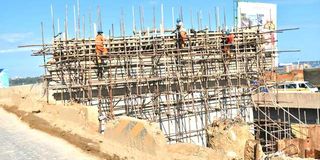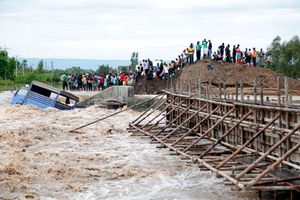
Workers at the site of a bridge under construction at the Changamwe roundabout Interchange on June 30, 2021.
Two State agencies are on the spot over irregular expenditure of taxpayers’ Sh24.86 billion on the Mombasa port access road project.
In a forensic audit, Auditor-General Nancy Gathungu queried the value for money in implementing the project by the Kenya National Highways Authority (KeNHA) and the National Land Commission (NLC).
The report faults the roads agency for allegedly disregarding feasibility reports as it implemented an alternative to the 41.7-kilometre road and therefore exceeded what would have been the cheapest alternative by over Sh5 billion.
The forensic audit for November 2023, currently before parliament, raises questions, including why NLC failed to provide compulsory acquisition approvals from the Ministry of Transport and Infrastructure Cabinet Secretary of the land for the project.
There was also lack of documentation on the involvement of the State Department for roads before the signing of the financial agreements, lack of documentation on identification and planning prior to start of the project and lack of papers on the identification of donors.
The audit has taken issue with unsupported and double payments, non-valuation of 13 parcels of land by NLC and failure to occupy the pieces already paid for by KeNHA.
The project starts at the junction of Kenyatta Avenue and Digo Road to Mariakani weighbridge within Mombasa County.
“The major irregularities noted by the audit team include failure to provide documents, unexplained variances, irregular payments to State organs and non-disbursement of funds,” the audit says. The audit shows that NLC irregularly paid public funds for six parcels of land belonging to six State firms- KenGen, Kenya Revenue Authority (KRA), Kenya Power, National Housing Corporation (NHC), Kenya Railways Corporation (KRC) and Coast Water Works Development Agency.
The parcels owned by Kenya Power, KenGen, KRA and Coast Water Works were estimated at Sh470.1 million but the Kenya Railways and NHC parcels were not valued.
According to the appraisal report by the African Development Fund (ADF) of February 2015, the overall project cost estimate net of taxes was Sh24.86 billion.
This included Sh23.74 billion co-financing by ADF Sh105 billion, Germany Development Bank (KfW) Sh5.52 billion, European Investment Bank (EIB) Sh5.52 billion, Africa Infrastructure Trust Fund (AITF) Sh2.21 billion.
The government’s financing component of Sh1.12 billion was meant for compensation of the project-affected persons.
The audit also reveals that the evidence on how financiers were identified was not provided for audit review.
It further notes that although KeNHA appointed AECOM SA (Pty) Limited, SAI consult, Aquaclean services and Panafcon Development Limited to undertake various consultancy services, it could not provide contracts supporting the consultancy.
This means that the auditors could not establish when the consultants were appointed.
But even as this emerged, the auditors have also flagged the difference of Sh9.7 billion between the project cost of Sh24.86 billion and the project budget of Sh15.2 billion as it was not explained.
What puts KeNHA in a tight spot is that a feasibility report was performed for four alternatives and it was stated that alternative 4 was expected to provide the highest return on investment and thus the preferred option
Alternative 1 to cost Sh26.82 billion, involved a dual carriageway road with a concrete pavement- interchange at Changamwe.
Alternative 2 which was billed at Sh24.04 billion, had a dual carriageway road with asphalt pavement with an interchange at Changamwe.
The third alternative was to cost Sh24.54 billion and had dual carriageway road with concrete pavement northbound and asphalt pavement southbound with an interchange at Changamwe.
The fourth alternative and the last, at Sh19.15 billion, was the cheapest of the other three.
It had a dual carriageway road with concrete pavement northbound and asphalt pavement southbound with a signalized intersection at Changamwe.
However, KeNHA implemented alternative 3 resulting in a cost increase of Sh5.39 billion compared to alternative four “and did not provide a justification for changing from the fourth to the third alternative.”
KeNHA management did not provide annexes or budget approval and board appropriations for 2021/22 in lot 1 and 2020/21 and 2021/22 in lot 2 for audit review.
The KeNHA board minutes for the project were also missing.







